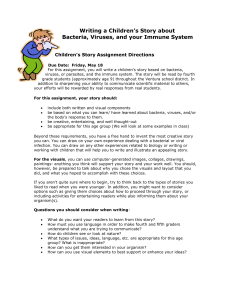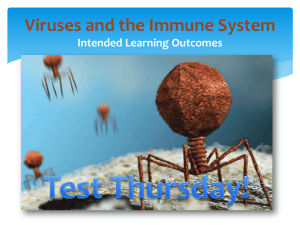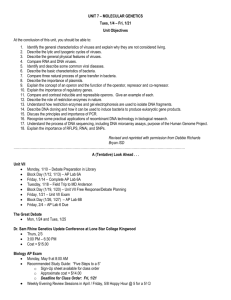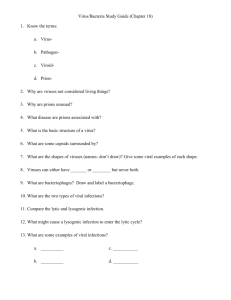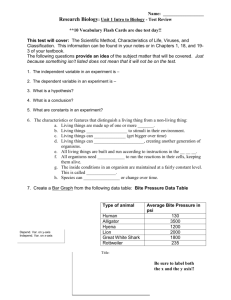Bacteria & Viruses
advertisement
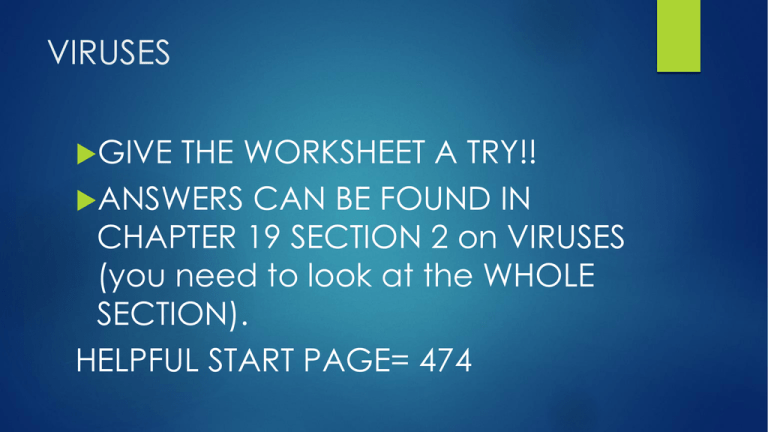
VIRUSES GIVE THE WORKSHEET A TRY!! ANSWERS CAN BE FOUND IN CHAPTER 19 SECTION 2 on VIRUSES (you need to look at the WHOLE SECTION). HELPFUL START PAGE= 474 Bacteria & Viruses WHAT’S THE DIFFERENCE?? A little review… A little review… Prokaryotes are DIVERSE • shape, • the chemical nature of their cell walls, • the way they move, • and the way they obtain energy. A little review… ARCHEABACTERIA Live in EXTREME conditions. Do NOT have PEPTIDOGLYCAN in their cell walls Their DNA is so similar to Eukaryotes – possible ancestors Example: Methanogens EUBACTERIA NEWER bacteria It’s all around YOU In our intestines Water systems Land Has PEPTIDOGLYCAN in its cell wall E. coli Eubacteria come in all shapes… Bacilli (Rods) E. coli Cocci (Spherical) Streptococcus Spirilla (spiral) Spirillum volutan Eubacteria also differ in their… Cell Walls Have really thick peptidoglycan covered OR Thinner walls surrounded by a lipid layer Movement Non movers Move slowly in their own secretion Have flagella that propel them along quickly! Eubacteria also differ in the way they eat… Chemoheterotrophs- Photoheterotrophs- consumers consumers photosynthetic & Chemoautotrophs- use carbon compounds to make food w/out sunlight. Photoautotrophs- do photosynthesis like green plants; no chloroplasts but have chlorophyll a Eubacteria have different forms of release of energy Obligate aerobes- have to have oxygen; do cell respiration Obligate anaerobes- do fermentation; “allergic” to oxygen Faculatative anaerobes- can do either one. Can live just about anywhere. IMPORTANCE OF BACTERIA Producers that capture energy by photosynthesis. Decomposers—breaking down nutrients Ex. Nitrogen fixation Human uses- Remove poisons, break down petroleum, used to make yogurt, mine minerals, syntesize drugs E.coli in our lower intestines, make vitamins we can’t get, further break down our food Viruses: “Poison” – RNA or DNA surrounded by protein coat INFECTS BACTERIA How viruses infect Lytic Infection- Virus “tricks” its way into cell- CAPSID Cell replicates viral DNA Cell assembles new viral proteins Cell bursts or lyses from too many viruses. Lysogenic infection- Viral DNA is inserted into the DNA of the host cell, then just sits there until something triggers the lytic cycle. When with it. host cell replicates, the viral DNA is replicate Retroviruses Nucleic acid is RNA instead of DNA Some retroviruses cause cancer in animals (including humans). HIV is a retrovirus (causes AIDS). HIV Human Immunodeficiency Virus Why is it so dangerous? No cure, only treatment Attacks/Disables Host key cells in immune system (helper T cells) no longer able to fight off infection May remain latent for long periods. Infected person may appear healthy but is contagious. Lysogenic Phase (latent stage)- Viral DNA inserted into host cell’s DNA and copied prior to cell division. Lytic Phase (active stage) – Viral Proteins rapidly reproducing and infecting many cells Viruses vs Cells VIRUSES Are not made up of cells Can’t live without host Don’t respond to environment Don’t obtain or use energy CELLS Reproduce Grow Can live without host cells Respond to their environments Obtain energy (autotrophs or heterotrophs Release energy (aerobic or anaerobically). Viruses and cells both Reproduce Have a genetic code (DNA or RNA) Evolve Common Viral Diseases Rhinoviruses cause the common cold HPV (Human papillomavirus) can cause cervical cancer in women Herpes simplex viruses cause mouth and/or genital sores, lesions, and ulcers. Influenza HIV viruses cause the flu (Human Immunodeficiency Virus) causes AIDS and weakens the immune system Rabies Chicken pox Hand, foot and mouth disease shingles Controlling Viruses PREVENT – with vaccines http://www.pbs.org/wgbh/nova/teachers/body/genetic-engineer-avian-flu.html TREAT – with rest and hydration for most viral infections Antiviral drugs available for some viral infections (limited success) Antibiotics DO NOT work on viruses. Controlling Viruses Vaccines stimulate the immune system to create antibodies that recognize a certain virus. Vaccines These will NOT cure you if you are already sick. antibodies patrol your body and if they recognize that virus…they call in reinforcements and your immune system goes to battle! How do we fight Illness? Immune system- cells that inactivate or destroy pathogens Nonspecific Skin, mucus, sweat, tears Inflammatory response Fever Specific Hummoral Acquired Immunity Immunity Nonspecific Immunity Skin Mucus, Break saliva, tears contain lysozymes down cell walls of bacteria Inflammatory White Response –happens if tissue damage blood cells: granulocytes that engulf (EAT) pathogens Infected tissue becomes painful and swollen Fever Chemicals released by immune system raise body temperature, so that pathogens can’t survive. Heart rate increases, producing more white blood cells Specific Immunity Antigens trigger the response Viruses, “Self” bacteria, and other pathogens that trigger immune response and “Non-self” Lymphocytes Tag, (T Cells and B Cells) destroy and remember foreign bodies including pathogens Acquired Immunity The production of immunity against diseases Vaccination Injection of a weakened form of a pathogen to stimulate immune system Antibiotics Compounds that kill bacteria without harming host cells (prevent bacterial reproduction) No effect on viruses


